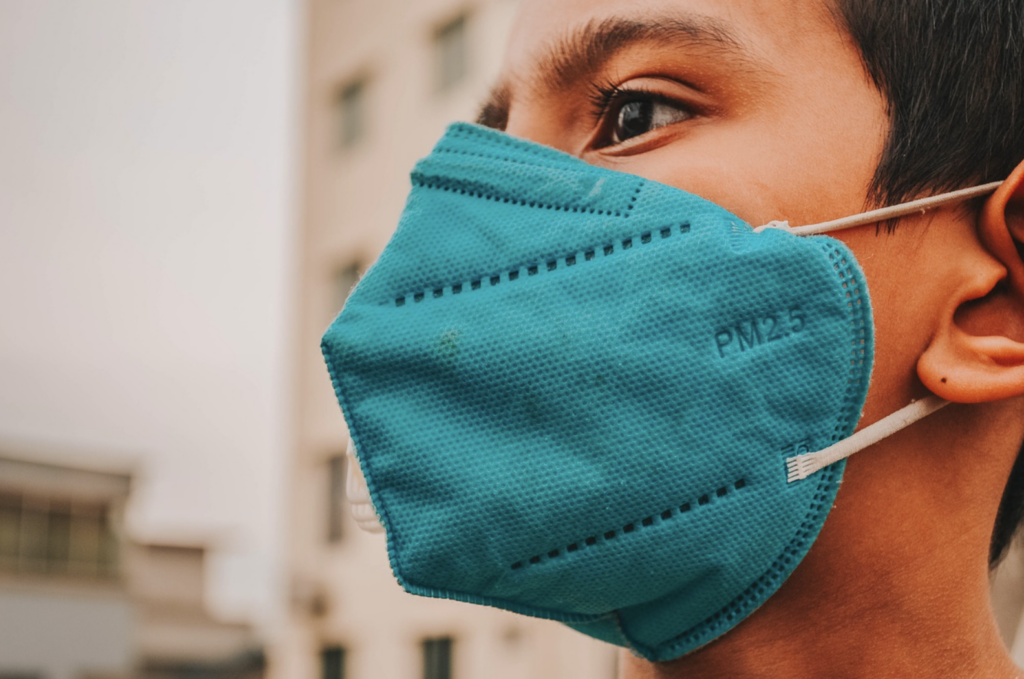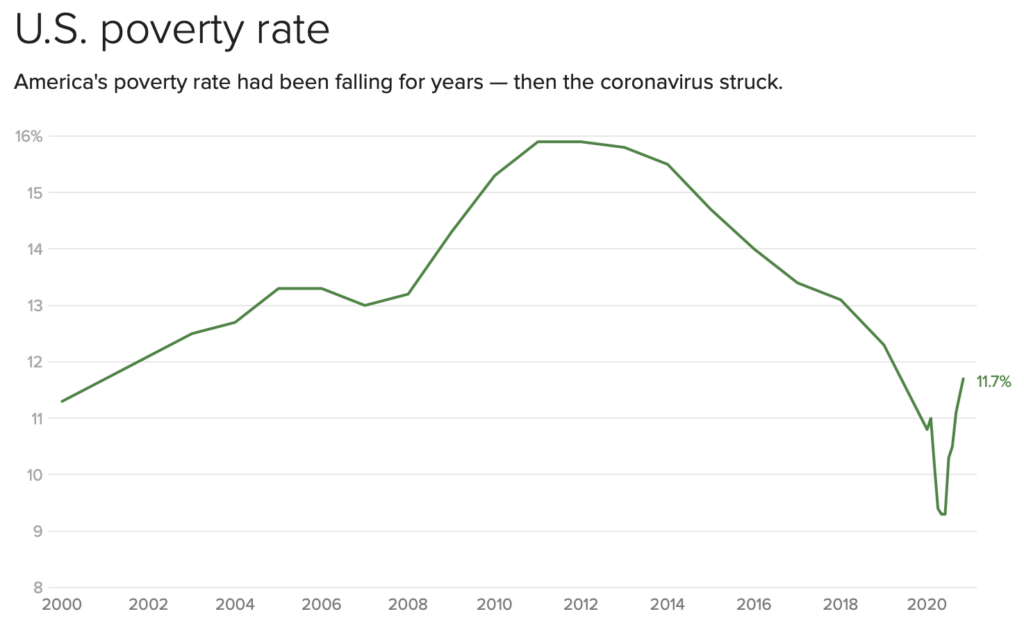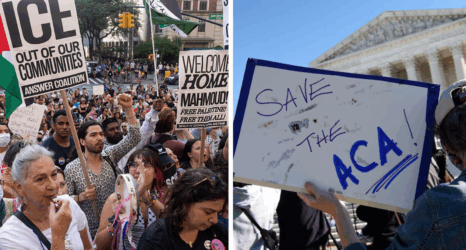For The Weekly Pulse (a revisit of an old Ms. column!), we’ve scoured the most trusted journalistic sources—and, of course, our Twitter feeds—to bring you this week’s most important news stories related to health and wellness.
In this edition of The Weekly Pulse: Poverty rates see the largest increase in 60 years, while Congress debates COVID relief packages; updates on the coronavirus pandemic and vaccine; and, the repro health rundown.
Pandemic Updates: First Over the Counter, At-Home COVID-19 Test Coming in January
+ More than 300,000 people have died due to COVID-19 in the U.S., and it’s been less than a month since we reported 250,000 deaths. And although coronavirus vaccinations have begun, experts say we will likely reach 400,000 deaths within the next month. The number of new cases continues to surge, even as states and local governments try to take measures to prevent the virus’s spread.
+ On Dec. 15, the FDA authorized the first over-the-counter at-home rapid COVID-19 test. The Ellume COVID-19 Home Test requires a nasal swab and users will receive their results via a smart-phone app that connects to a Bluetooth-connected analyzer device. Each test will cost around $30 and can be taken by anyone over the age of two.
The test will become available at the beginning of the new year and Ellume expects to produce 3 million tests in January 2021. Although this is great news for a country that has struggled to provide enough testing, the “FDA reminds patients that all tests can experience false negative and false positive results” and to follow-up with a health care provider when they receive a positive result or experience symptoms after a negative result.

+ The CDC is working on developing minimum filtration efficiency standards for face masks. Since the pandemic began, neither the FDA nor the CDC has offered much clarity on which types of face masks are most effective—prompting public health experts to express frustration at the lack of guidance (especially considering there is sufficient evidence showing well-fitted, multiple-layered masks are most effective).
“There’s been a critical need for some kind of national program to test and certify masks, and to communicate with people how to use and care for them,” Linsey Marr, a professor at Virginia Tech and a leading expert on airborne viruses, told The New York Times.
The CDC plans to create labels for face masks that indicate their efficacy, which will both help consumers choose more effective masks and push manufacturers to meet the filtration efficiency standards.
Poverty Rates See Largest Increase in 60 Years
+ Over the past six months, the COVID-19 pandemic has forced nearly 8 million Americans into poverty—the largest increase in over 60 years. In June, the nation’s poverty rate was at 9.6 percent and has since jumped to 11.7 percent this November.
Research from three separate universities shows that U.S. poverty rates actually declined during the beginning of the pandemic thanks to small business relief, stimulus checks and increased unemployment benefits among other aid—but it has since risen.
James X. Sullivan, professor of economics at Notre Dame, and Bruce D. Meyer, expert in poverty and inequality as well as professor at the University of Chicago’s Harris School of Public Policy, are tracking this data on a COVID Income and Poverty dashboard that registers the economic impacts of the pandemic. The study also includes economist Jeehoon Han from China’s Zhejiang University.
“The patterns tell a pretty straightforward and striking story,” Sullivan said. “At first we saw a decline in poverty even though unemployment rates were rising sharply, and the reason for that is the expanded benefits through the [Coronavirus Aid, Relief and Economic Security (CARES) Act] and from economic impact payments and more generous unemployment benefits and broader eligibility for them.”

According to the study, almost twice as many Black Americans are living in poverty and more women have fallen below the poverty line than men. Children and those with a high school education or less are especially at risk.
+ To ease this crisis, congressional leaders in both the House and Senate are close to striking a deal on a $900 billion relief bill and another round of stimulus checks. They are attempting to combine a coronavirus aid plan and a $1.4 trillion full-year spending bill into one package to keep the government running through September 30, 2021. Without a deal, crucial CARES Act unemployment aid is set to expire at the end of the month and an estimated 12 million Americans will lose their benefits—with women of color being hit the hardest.
On Thursday night, Senate Majority Leader Mitch McConnell (R-Ky.) said a “bipartisan, bicameral agreement appears to be close at hand” and it is “highly likely” lawmakers would work through the weekend and pass an emergency temporary spending bill if they cannot strike a deal before the current bill expires midnight Friday. House Speaker Nancy Pelosi (D-Calif.) also told reporters that Democrats have “made some progress [Thursday] morning” and “are waiting to hear back.” Once Congress passes relief legislation, it still has to make it past President Donald Trump.
While many details for the rescue plan are unknown, McConnell has confirmed that the package will include Paycheck Protection Program small business loans, another direct payment, funds for COVID testing and vaccine distribution as well as an extension of the unemployment benefits expansion.
The package is also expected to include roughly $300 billion in small business aid, extend the eviction moratorium and reinstate a federal unemployment insurance supplement. It is expected that the direct payments will be $600 per person and $600 per child for at least two children—a 50 percent decrease from the initial $1,200 payment.
+ Even with progress being made, our leaders must act quick. Americans need this money just to survive and feed their families as food insecurity has doubled since last year, and is reaching its highest level since 1998. Nationwide, more people than ever are turning to their local food banks, and many are first-timers who have never before needed meal assistance.
“We saw folks who had just never needed to access this type of resource before,” says Loudon Hunger Relief executive director Jennifer Montgomery. “It was obvious that they were very much one or two pay checks away from being in serious trouble.”
Others fighting this hunger crisis say they have never seen anything like this in America, even during the Great Recession of 2007-2009.
Vaccinations Kick Off in United States
+ Sandra Lindsay, a nurse in New York City, was the first person to receive a coronavirus vaccine in the U.S. after the FDA issued an emergency use authorization for the COVID-19 vaccine developed by Pfizer and BioNTech. Lindsay said her goal was not to be “the first one to take the vaccine, but to inspire people who look like me, who are skeptical in general about taking vaccines.”
The FDA is expected to issue another emergency use authorization for a COVID-19 vaccine developed by Moderna. But public health experts warn that while widespread vaccination is an important step towards ending the pandemic, we will still need to continue to practice social distancing and mask wearing for the foreseeable future.
+ Even though the development of COVID-19 vaccines is a tremendous scientific achievement, there are still numerous hurdles to clear before there is widespread vaccination globally. In the U.S., states reeling from the economic crisis lack the funds necessary to carry out vaccinations.
Plus, vaccinations present a global justice issue: wealthier countries are buying up the vaccine (and buying doses than they need), meaning at least one fifth of the global population may not be vaccinated until 2022.
+ At a national vaccination “kick off” event planned by the U.S. Department of Health and Human services, public health officials stressed the importance of Americans getting vaccinated. The Trump administration, after months of playing down the pandemic, is set to begin a 250 million dollar public education campaign to encourage people to get vaccinated.
Vaccine hesitancy is a formidable barrier in the public health fight against COVID-19, but luckily a new Pew Research poll found 60 percent of Americans say they will “definitely” or “probably” take the vaccine—up from 51 percent in September.
+ Vaccine hesitancy is especially high among Black and Latino Americans, due to the U.S. government’s long history of non-consensual medical experimentation on Black people and people of color. The government’s terrifying historical legacy presents a uniquely challenging barrier to vaccinating these communities, who are also the ones suffering from COVID-19 outbreaks disproportionately. (Check out this article from Ms. contributor Katherine Buaron for a more in-depth look at this vaccine distrust among people of color.)
Repro Rundown
+ In the first quarter of 2021, the Trump administration is planning to withhold $200 million in Medicaid funding from California due to the state’s mandate that health insurance providers include elective abortion care in their coverage.
According to Health and Human Services Secretary Alex Azar, an additional $200 million will be withheld from the state each quarter they continue to implement that policy. Azar seems to have forgotten that the Trump administration will end on January 20, 2021.
“We’re taking enforcement action against the state of California for imposing universal abortion coverage mandates on health insurance in the state,” Azar announced. “We have informed California that this policy clearly violates federal conscience laws but the state refuses to fix the issue and comply. Accordingly, we plan to withhold $200 million in federal Medicaid funds from the state in the first quarter of 2021. And unless California amends its policies we will seek to withhold an additional $200 million every quarter until it complies.”
+ According to a new study by The Guttmacher Institute, almost 60 percent of teenagers have had sex by the time they graduated high school. Nationally, 38 percent of teens said they had engaged in sexual intercourse.
“It doesn’t matter where teens live in the U.S., normal adolescent development includes increasing sexual activity and for many, a transition to having sex,” said Laura Lindberg, lead author on the study and a principal research scientist with the The Guttmacher Institute.
+ The Trump administration is once again asking the Supreme Court to reinstate a rule requiring that patients looking to receive medication abortion pick up the pills in person.
Last week, U.S. district Judge Theodore Chuang rejected the administration’s arguments due to the health risks associated with the COVID-19 pandemic. Chuang also believes that advancements in the COVID vaccine and treatments have not yet “meaningfully altered the current health risks and obstacles to women seeking medication abortions.”
+ State lawmakers in Massachusetts are attempting to override Gov. Charlie Baker’s recent rejection of parts of a budget amendment increasing access to abortion care in the state. The amendment specifically includes language that would increase access to “late-term” abortions as well as lower the age at which minors can receive an abortion without parental consent.
Gov. Baker—a pro-choice Republican—said he was unhappy with the Legislature making major policy changes within a spending bill and “cannot support the other ways that this section expands the availability of late-term abortions and permits minors age 16 and 17 to get an abortion without consent of a parent or guardian.”
+ On Tuesday, the 8th U.S. Circuit Court of Appeals decided not to reconsider its decision to lift a judge’s ruling that blocked four Arkansas abortion restrictions from going into effect.
The 2017 laws at issue are:
- Act 45—banning dilation and evacuation;
- Act 1018—requiring doctors to notify law enforcement if anyone 16 or younger receives an abortion;
- Act 733—requiring doctors to review a patient’s medical records if they know the sex of the fetus being aborted (to ensure it is not a sex-selective abortion);
- Act 603—regulating the disposal of abortion remains and requiring the patient to notify their partner or family.
The ACLU of Arkansas will continue efforts to prevent the legislation from going into effect—something executive director Holly Dickinson says could happen within seven days if no more legal action is pursued.
“We will take further action,” Dickson told the Arkansas Democrat-Gazette Tuesday night. “We’ve got two ways we can go—petition the U.S. Supreme Court or go back to district court. This gives us seven days to take our next steps to try and enjoin these laws from taking effect.”
You may also like:





